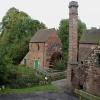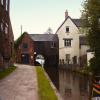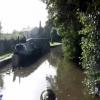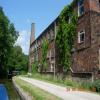
| Cheddleton Lock No 14 | 1½ furlongs | |
| Cheddleton Bridge No 43 | 1 furlong | |
| Cheddleton Lock No 13 | ¾ furlongs | |
| The Flintlock Restaurant at Cheddleton | ½ furlongs | |
| Cheddleton Bridge No 42 | ½ furlongs | |
| Cheddleton Flint Mill | ||
| Cheddleton Flint Mill Winding Hole | a few yards | |
| Springs Bridge No 41 | 1¾ furlongs | |
| Wood Top Bridge No 40 | 3¼ furlongs | |
| Wall Grange Bridge No 39 | 7¼ furlongs | |
| Deep Hayes Aqueduct | 7¾ furlongs | |
- Trent & Mersey Canal Society – founded in 1974 — associated with Trent and Mersey Canal
- Caldon & Uttoxeter Canals Trust — associated with Trent and Mersey Canal (Caldon Branch)
Mouseover for more information or show routes to facility
Nearest water point
In the direction of Froghall Tunnel (southwestern entrance)
In the direction of Etruria Junction
Nearest rubbish disposal
In the direction of Froghall Tunnel (southwestern entrance)
In the direction of Etruria Junction
Nearest chemical toilet disposal
In the direction of Froghall Tunnel (southwestern entrance)
In the direction of Etruria Junction
Nearest place to turn
In the direction of Froghall Tunnel (southwestern entrance)
In the direction of Etruria Junction
Nearest self-operated pump-out
In the direction of Etruria Junction
Nearest boatyard pump-out
In the direction of Etruria Junction
Wikipedia has a page about Cheddleton Flint Mill
Cheddleton Flint Mill is a water mill situated in the village of Cheddleton in the English county of Staffordshire. The mill race takes water from the river Churnet and the site is believed to have been used for milling since the Middle Ages. However, the present structures date from the period of the Industrial Revolution.
There are actually two mills: one was purpose-built to grind flint for use in the pottery industry, and the other was converted to the same purpose from use as a corn-mill. The mill complex includes a miller's cottage, two flint kilns, a drying kiln and outbuildings, and is adjacent to the Caldon Canal.
The complex was listed grade II* in 1986 (the buildings being separately listed). It is now maintained and operated by the Cheddleton Flint Mill Industrial Heritage Trust, a registered charity under English law.















![Cottage and Mill at Cheddleton, Staffordshire. Cheddleton Flint Mill industrial museum. There is a Grade II* listed complex of buildings here which includes two water mills, cottages, kilns and outbuildings. Flint was milled here by the River Churnet (the Caldon Canal is to the right of the chimney).See also [[[2472412]]]http://people.exeter.ac.uk/akoutram/cheddleton-mill/about.htm by Roger D Kidd – 27 May 2011](https://s3.geograph.org.uk/geophotos/02/47/27/2472743_01db45b1_120x120.jpg)

![Cheddleton Flint Mill Museum, Staffordshire. There is a complex of buildings here which includes two water mills, cottages, kilns and outbuildings. Flint was milled here by the River Churnet (the Caldon Canal is to the right of the cottage).See also [[[2472412]]]http://people.exeter.ac.uk/akoutram/cheddleton-mill/about.htm by Roger D Kidd – 27 May 2011](https://s0.geograph.org.uk/geophotos/02/47/27/2472736_2a64c576_120x120.jpg)








![Cheddleton Flint Mill - Robey Engine. The Robey's of Lincoln 100HP drop valve single cylinder engine from Minton Ltd, Stoke on Trent. The engine, in former workshops doesn't belong here as the site never had steam. [[[656247]]] by Ashley Dace – 03 March 2012](https://s1.geograph.org.uk/geophotos/02/83/59/2835997_e12ccaf7_120x120.jpg)






![Cheddleton Flint Mill - Robey Engine. The Robey's of Lincoln 100HP drop valve single cylinder engine from Minton Ltd, Stoke on Trent. The engine, in former workshops doesn't belong here as the site never had steam. [[[656247]]] by Ashley Dace – 03 March 2012](https://s3.geograph.org.uk/geophotos/02/83/59/2835987_eb422a73_120x120.jpg)


![Cheddleton Flint Mills, Staffordshire. Seen in early evening sunlight.From http://people.exeter.ac.uk/akoutram/cheddleton-mill/about.htm we are informed that Cheddleton Flint Mill consists of a complex of buildings (Grade II* listed) including two separate water mills, a miller's cottage, two flint kilns, a drying kiln and outbuildings. The Caldon Canal, which would have supplied the mill by narrow boat, passes by.Also, it is known that milling at Cheddleton dates back to 1253. The foundations of the South Mill may date back to this period. A 1694 reference mentions corn milling at the site. In the late 18th century the complex was converted to grind flint and the North Mill (on the left) was added specifically for that purpose, while the South Mill was converted to grind flint instead of corn.To see a 1981 image: [[[2237242]]] by Roger D Kidd – 27 May 2011](https://s0.geograph.org.uk/geophotos/02/47/27/2472756_e6b81450_120x120.jpg)



